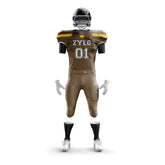The Psychology Of Color In Basketball Uniforms
When you think of the Los Angeles Lakers, their bold purple and gold instantly come to mind. For the Boston Celtics, it’s the classic Kelly green. These colors aren’t random—they’re strategic tools designed to inspire players, intimidate rivals, and unite fans. The psychology of color in basketball uniforms blends science, culture, and branding, creating a visual language that impacts the game on and off the court. Let’s break down how colors shape performance, perception, and identity in basketball.
The Science of Color Psychology
Color psychology examines how hues influence human emotions and behavior. Studies show that colors can:
-
Elevate heart rate and aggression (e.g., red).
-
Promote calmness (e.g., blue).
-
Signal energy and optimism (e.g., yellow).
In sports, these effects are amplified. A 2005 study in Nature found that athletes wearing red had a slight competitive edge, possibly due to its association with dominance. Basketball teams leverage these insights to craft uniforms that subconsciously sway outcomes.
Red: The Color of Dominance
Red is a powerhouse in sports psychology. Linked to danger, passion, and aggression, it’s no coincidence that teams like the Chicago Bulls and Houston Rockets use red prominently. Research suggests:
-
Increased perceived aggression: Opponents may view red-clad players as more dominant.
-
Boosted confidence: Wearing red can enhance a player’s self-assurance during high-pressure moments.
However, overuse might backfire. Referees in a 1988 study penalized teams in black uniforms more harshly, hinting at potential bias against “aggressive” colors.
Team Identity and Branding Through Color
Uniforms are a team’s visual signature. The Lakers’ purple and gold evoke royalty and legacy, while the Celtics’ green honors their Irish roots. Key branding benefits include:
-
Fan loyalty: Colors create emotional bonds; fans wear jerseys to show allegiance.
-
Merchandising: Iconic color schemes drive apparel sales.
-
Recognition: Consistent colors ensure instant team identification worldwide.
When the Toronto Raptors rebranded to "North" red in 2020, they blended regional pride with modern design, proving color’s role in evolving team identity.
How Colors Affect Opponents and Referees
Colors don’t just motivate wearers—they unsettle opponents. Bright hues like neon yellow (e.g., Michigan’s “Maize”) enhance visibility, aiding quick passes but also drawing referees’ eyes. Studies reveal:
-
Contrast matters: High-contrast uniforms improve player coordination.
-
Referee bias: Darker colors may subconsciously signal aggression, leading to more foul calls.
Teams like the San Antonio Spurs opt for sleek black uniforms to project toughness, balancing intimidation with practicality.
Cultural and Regional Influences
Colors carry cultural meanings that teams harness:
-
White: Symbolizes purity in Western cultures but signifies mourning in parts of Asia.
-
Gold: Associated with success and luxury globally.
-
Green: Represents nature in the U.S. but holds religious significance in some countries.
International teams, like Spain’s national squad, often incorporate national flag colors to foster unity and pride.
Practical Design Considerations
Beyond psychology, functionality drives uniform design:
-
Visibility: Bright colors help players spot teammates mid-game.
-
Fabric technology: Moisture-wicking materials in bold hues balance performance and style.
-
Tradition vs. innovation: Teams like the Golden State Warriors blend classic blue and yellow with modern, lightweight designs.
Conclusion
The psychology of color in basketball uniforms is a game of strategy. From sparking player confidence to unsettling opponents, colors are silent yet powerful players on the court. As teams evolve, their palettes will continue to reflect science, culture, and the relentless pursuit of victory. Next time you watch a game, consider the hidden stories behind the hues—they might just change how you see the sport.
Check out our custom basketball jerseys and gear up in style!


